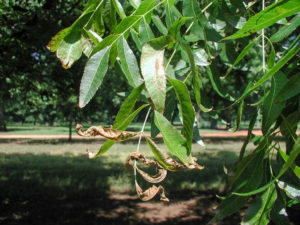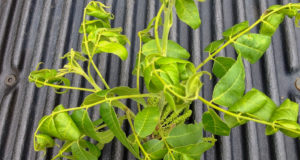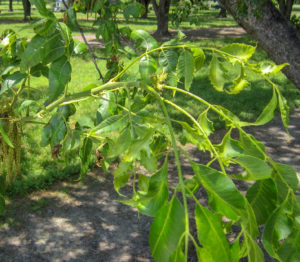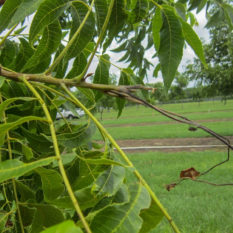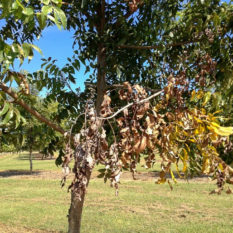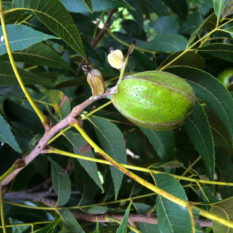Handling Herbicide Drift in Pecan Orchards

Glyphosate injury versus zinc deficiency of pecan. Note the thin, “strappy” leaves of glyphosate exposed leaves on the left and in the center versus the wavy or curly leaf edges of zinc deficient foliage on right. (Photo by Lenny Wells)
Pecan growers should be aware of crops planted in adjacent fields and the herbicide practices used for that crop. Since adjacent land may be owned by other farmers, cordial conversations with neighbors are an important first step in the prevention of accidental herbicide injury. Producers of agronomic crops often are not aware of the potential injury and value of pecan trees and the pecan crop.
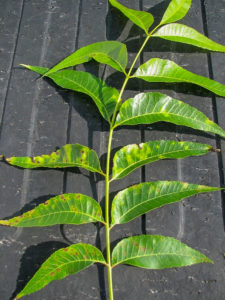
Paraquat drift injury to pecan foliage. Damaged areas turn yellow or chlorotic initially, and then as the affected tissue dies, damaged areas turn brown. Glufosinate injury may appear similar. (Photo by Lenny Wells)
Herbicide drift is usually quite proximate to the herbicide application site and can be significantly reduced or prevented using proper application techniques. Injury symptoms resulting from these droplets may be obvious and consistent on a selection of trees in the portion of the orchard near the application area and will often decrease in severity the further one moves from the sight of origin.
Plant damage from volatilization of herbicides is much less common and harder to diagnose. It is also difficult to prove or consider pesticide misuse. Damage has been known to occur miles from the application site, depending on the herbicide involved and sensitivity of plants damaged.
If growers suspect accidental herbicide damage to one or more of their orchards, an orderly series of steps should be taken. Documentation of the damage is of the utmost importance. Some valuable information to note will be the date the injury or application was noticed and the number of trees or acreage damaged. A summary of the symptoms of damaged plants should be written down. If the injury is severe and the grower is considering seeking compensation for the damage, one should follow this step by collecting a combination of photos and plant samples as quickly as possible. Growers may take their own tissue samples for detection of herbicide residue to a state or private laboratory. However, bear in mind that these analyses may cost over $100 per sample depending on the herbicide in question. Samples for certain herbicides or chemicals must be taken within two to three weeks of exposure to be easily detected. Also, these samples are rarely used in any drift case. They usually offer little more than peace of mind to the affected producer. Usually, the state Department of Agriculture must take plant samples for residue testing if a formal complaint is filed.
After ruling out one’s own negligence (e.g., use of a herbicide-contaminated sprayer to apply other pesticides or herbicide drift from within the orchard) attention should be turned to “off-farm” sources. If the damage is most severe in trees adjacent to a recently sprayed field and wind conditions were favorable for drift, there is often fairly strong evidence that the neighbor’s action caused the injury. Patterns in planting can help determine the source of contamination. A change in the intensity of symptoms in the orchard may indicate the direction from which the herbicide originated.
Many herbicide drift incidents do not result in economic loss; however, economic loss can occur if the injury is severe enough. Often the severity of damage cannot be determined initially and only time will tell the extent to which the trees or crop may or may not recover. Injury after July 1 will be more damaging to the following year’s pecan crop than injury occurring earlier in the growing season as a result of the tree’s physiological processes required for the following year’s fruiting.
Symptoms
Depending upon the environmental conditions at the time of application, the herbicide used, rate, timing, and coverage, the trees may vary in their response to herbicide drift. The most common herbicides involved in drift injury to pecan are glyphosate, glufosinate, paraquat, and flumioxazen. With the recent release of 2,4-D and dicamba-resistant crops, injury from these herbicides may become more common. Regardless of the herbicide in question, it may take time to determine the extent of damage. It may be necessary to harvest damaged trees separate from non-damaged trees in order to document any economic loss. Insurance companies often use a comparison of crop yields in the year of damage with the previous 3-year average, which emphasizes the importance of keeping good farm records. A description of the herbicides mentioned above and typical symptoms of their injury to pecan is provided below:
Glyphosate: Glyphosate commonly causes damage to pecan trees when the chemicals contact the foliage and in the case of young trees (at most 3 years old) the green bark as well. In most cases in which isolated incidents occur, trees suffer some damage, leaf deformation, and defoliation; however, they usually re-foliate with only minor long-term effects and subsequent growth usually returns to normal. Glyphosate is a systemic herbicide and thus can potentially affect the trees for more than one year and yield may be reduced. The severity of damage is usually dependent on the rate of herbicide applied and the extent of coverage. In very severe cases, glyphosate can kill limbs; however, this is rare and would be evident within the first year or two following application. Repeated applications would have more significant, long-term effects, which could eventually result in the tree’s death. Primary symptoms of glyphosate injury are thin, strap-like leaves and often some chlorosis or yellowing. Heavy concentrations can cause die-back.
Paraquat: Paraquat is a contact herbicide that only burns the tissue it touches. The extent of damage will be dependent upon the concentration of herbicide in the spray mix and the coverage on the pecan tree. Usually, within 24 to 48 hours after contact, affected leaves will develop yellow areas where contact was made. If only a few yellow spots are observed on leaves, the damage is most likely not significant; however, if a large percentage of the leaf or leaves turn yellow, damage may be severe. The yellowed areas of the leaf turn brown and necrotic with age. Where a large percentage of the leaf surface is contacted, the foliage will die and drop from the tree. The same is true for pecan flowers, nuts, or any other green tissue which is contacted by the herbicide. In most cases, when paraquat is applied to a mature tree, the tree will re-foliate and it will not suffer long-term injury. Paraquat applied to the thin bark of young trees (around 3 years old or younger) can girdle the tree, resulting in tree death.
Glufosinate: Glufosinate is a contact herbicide and injury is very similar in appearance to that of paraquat; however, symptoms take a little longer to appear after application than they do for paraquat. Yellowed areas appear a few days after application and turn necrotic with age. Again, as for paraquat, the severity of injury will depend on herbicide concentration and coverage. Trees generally recover without long-term damage.
Flumioxazen: Flumioxazen is used primarily as a pre-emergence herbicide; however, it does have some post-emergence activity. It is often tank mixed with one or more of the herbicide chemistries listed previously. Injury symptoms are similar to that of glufosinate and paraquat. Trees generally recover quickly.
2,4-D: 2,4-D is a systemic herbicide used to kill broadleaf weeds. A member of the phenoxy family of herbicides, 2,4-D was one of the first successful selective herbicides developed and has been used for more than 70 years. Injury symptoms first appear as a folding or curling of foliage. Wrinkling, cupping, curling or twisting of foliage along with some chlorosis or yellowing of the foliage continues within a few days of contact. Affected tissue will turn necrotic and die back, often leaving a curled leaf stem if the concentration or coverage is great enough. We have observed experimentally serious injury—including death of foliage and limbs—at leaf tissue concentrations of 25 parts per million. 2,4-D can also arrest nut development at the stage at which contact with the herbicide occurred. Limbs or tissue receiving full coverage of a concentrated solution or full rate of 2,4-D will most likely die. We generally do not see evidence of translocation within pecan trees. Therefore, if only a small portion of the tree is affected or if the tree receives a low concentration of the material, it is not likely that the tree will be damaged long term. However, the larger the percentage of coverage on the tree and the higher the concentration of the material, the more severe the damage will be. Full exposure of auxin herbicides to an entire tree or to a large percentage of a tree at full rates can kill the tree.
Dicamba: Dicamba is another selective herbicide in the phenoxy family of herbicides designed to kill broadleaf weeds. Symptoms are similar to that observed for 2,4-D.
Herbicide Uptake by Tree Roots
In addition to damage from herbicide drift, pecans are susceptible to herbicide injury from root uptake. This may occur from pre-emergence herbicides applied to herbicide strips in the orchard in some situations, or more commonly from pre-emergence herbicides applied to adjacent row crop fields.
Diuron is a pre-emergence herbicide labeled for use on pecan trees for control of annual broadleaf weeds and some annual grasses only under trees established in the orchard for at least 3 years. However, injury can occur with this herbicide, particularly on sandy soils. This injury occurs most often when there is a heavy rainfall event within a few days following application. Symptoms appear as development of necrosis between the veins of pecan leaflets. Trees normally recover from this with minimal damage. At heavy rates, some limb die-back may occur, especially with repeated applications.
When peanuts are grown adjacent to pecan orchards injury from the uptake of imazapic by pecan roots can occur if this herbicide is used in the peanut field. Imazapic is a common postemergence herbicide used in peanut fields early in the growing season to control various broadleaf weeds, grasses, and sedges. Similar materials are sometimes used by highway right-of-way crews, and trees adjacent to right of ways are also at risk for uptake.
Imazapic is rapidly absorbed by plant roots and shoots, transferred to other parts of the plant, and then accumulates in actively growing tissues. Due to its soil residual activity, imazapic has long rotation restrictions before subsequent crops can be planted in the field. This long residual activity may sometimes cause damage on pecan to appear again the year after application. The heavier the soil, the longer it will take for rainfall to wash the herbicide out of the soil profile.
The roots of mature pecan trees can extend to a length twice the width of the tree canopy, often reaching into adjacent fields even when tree trunks and row crop fields are separated by 60 feet or more. When uptake of imazapic by mature pecan trees occurs, there are usually no visible external symptoms of damage. However, as harvest approaches, the pecan shucks do not split and kernel development is inhibited, resulting in hollow nuts or “pops.” As pecan fruit matures, ethylene is produced by the kernel to stimulate shuck split. Since the herbicide inhibits kernel development, there is no ethylene produced to open the shucks and they may remain closed on the tree through the harvest season.
When young pecan trees are transplanted into a field in which imazapic was used the previous year (and sometimes even 2 years prior on heavy soil) they can be injured to the point of death or at the very least stunted or have delayed growth. Young trees planted in imazapic treated areas often grow initially, then die back with this process repeating itself until the herbicide is flushed out of the field.
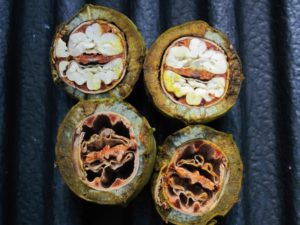
Imazapic injury to pecan nuts on the bottom of the image. Trees often absorb herbicide by root uptake from the soil of adjacent fields. Mature trees appear normal but kernels inside shuck fail to develop.
Herbicide Injury from Forestry and Pasture Applications
Forestry and pasture herbicides are sometimes used to eliminate broadleaf tree competition from pine plantation stands and cow pastures or hay fields. Commonly applied materials include Triclopyr, Imazapyr, hexazinone, Picloram, sulfometuron methyl, and metsulfuron methyl. Those materials with soil residual activity, such as imazapyr, may be of greatest concern if enough soil coverage is obtained. Since many of these materials are designed to kill broadleaf trees, shrubs, brush, and vines, they can be particularly damaging to pecan. As with any herbicide, the extent of damage to pecan will depend on coverage and concentration of the herbicide application. Damage from forestry and pasture herbicide overspray or drift is less common than that from row crop fields because larger nozzle sizes are more commonly used for forestry and pasture sprayers. However, there is often a greater risk of long-term damage from these materials than from row crop herbicides when drift does occur. In addition, planting pecan trees into pastureland or land where pine trees are cleared when there has been recent herbicide application (within 1 to 2 years) can lead to damage of newly planted pecan trees due to the long soil residual activity of many of these herbicides.
While no long-term injury may develop, each herbicide drift case is different and the level of injury is dependent upon the herbicide used, rate applied, wind speed and direction, timing, and the level of coverage obtained. Herbicide injury via root uptake can occur in some circumstances as well when there are other activities occurring adjacent to the pecan orchard. Any symptoms of injury should be documented as soon as possible after they are detected.

